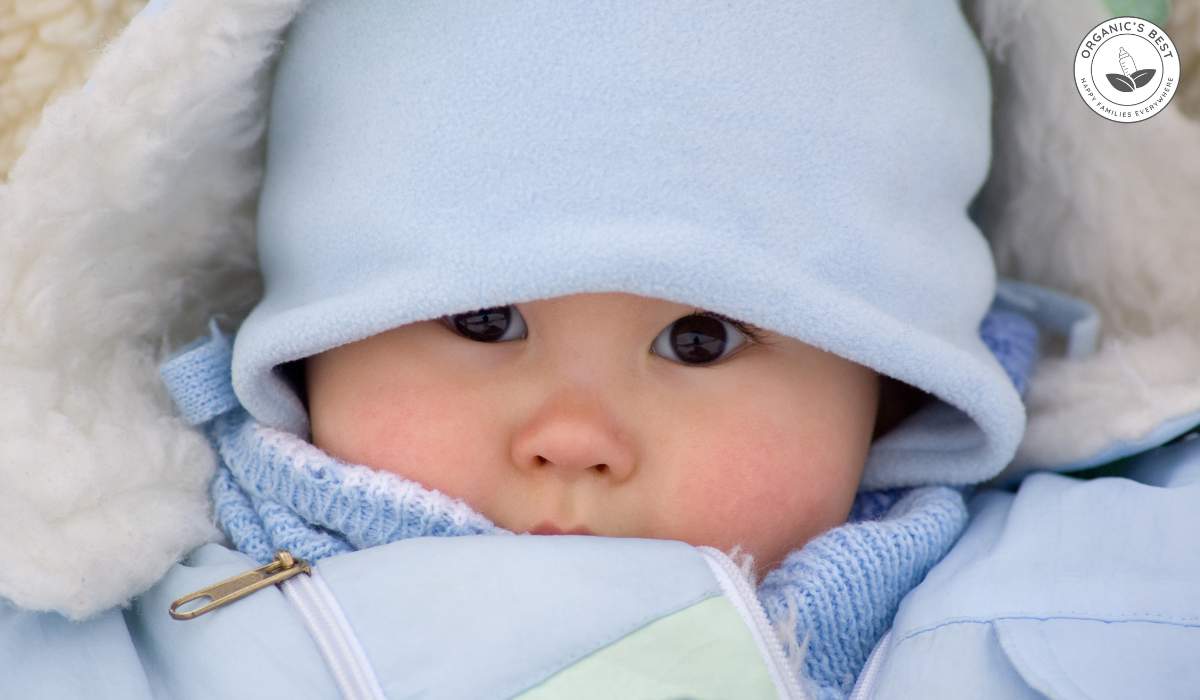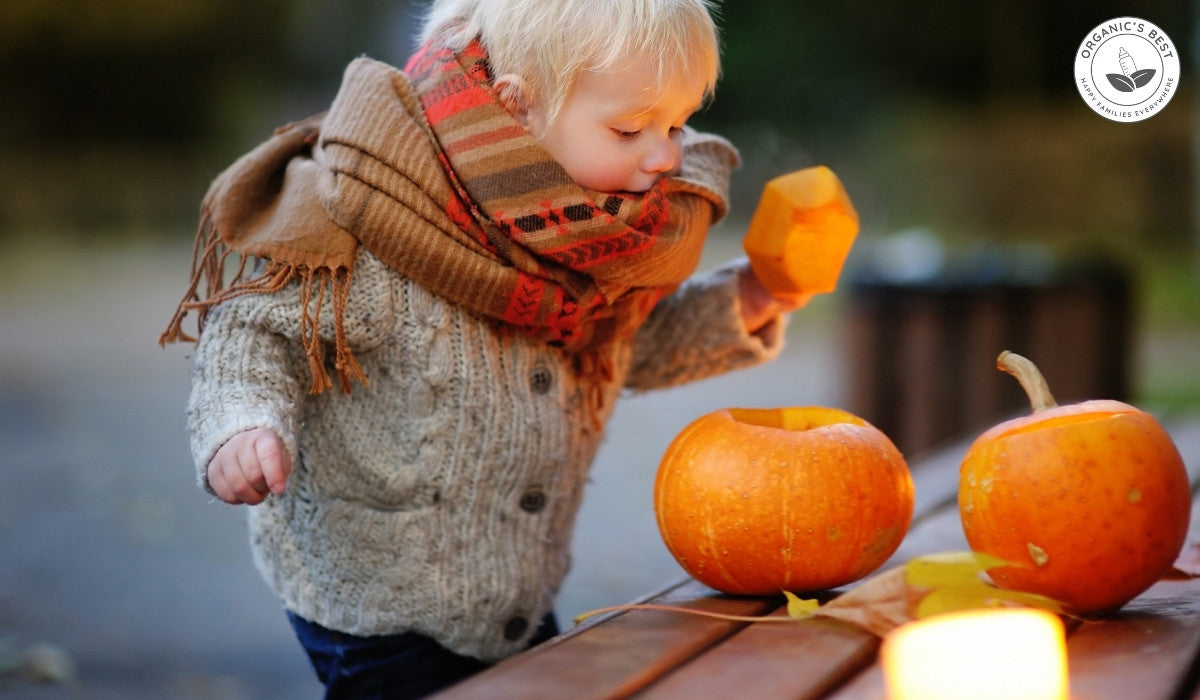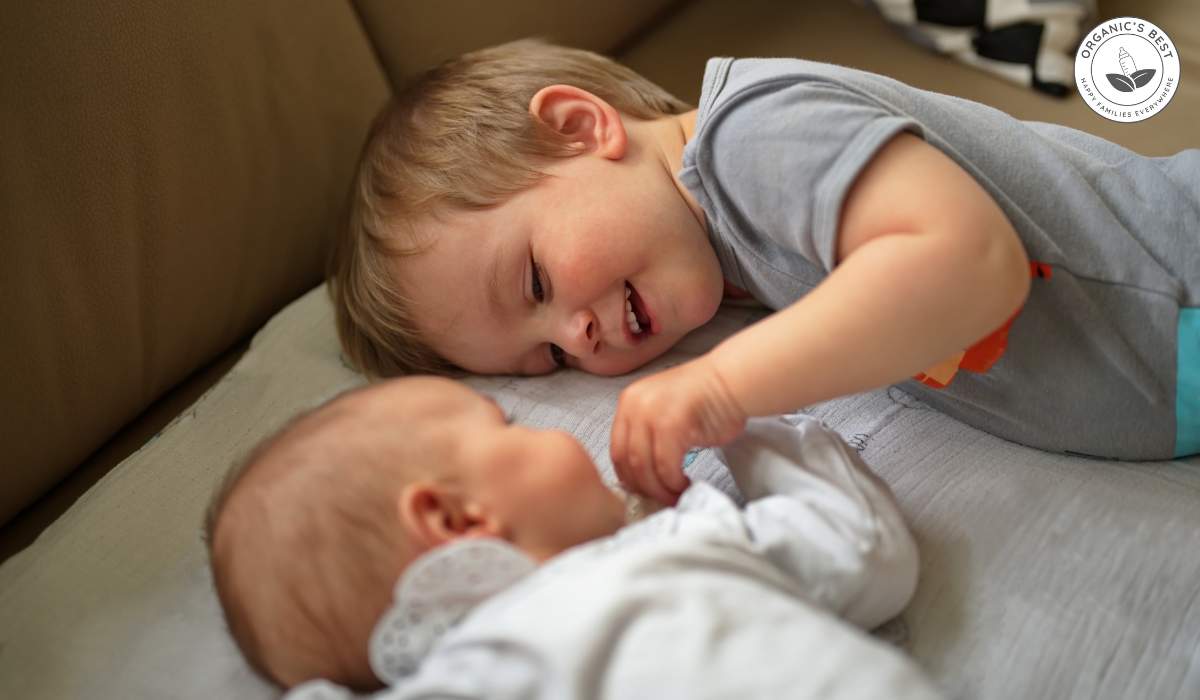Click to Get 2 FREE Boxes/Cans
BABY FORMULA
Offering new parents top-quality European infant formula from renowned brands like HiPP, Holle, Kendamil, and more. If you’re uncertain about which product to choose, our Formula Finder can help you make the best decision for your baby.
Baby Food
Offering new parents a premium selection of European baby foods, including jars, pouches, cereals, and snacks from esteemed brands like HiPP and Holle.
How to Dress Baby in Winter for Comfort and Warmth
by Agustina Fernandez November 25, 2025 8 min read

If you've ever stood at the door in the middle of January, baby in one arm and a pile of tiny hats, mitts, and warm baby clothes in the other, wondering if you're about to underdress or overheat your child, trust us, you're not alone. Too few layers and you imagine frostbite, but with too many, suddenly your little one is red-faced, sweaty, and probably a little cranky.
As adults, we can remove and add clothes as needed, but for babies, it is not that simple because they have a harder time regulating their body temperature. This is because they lose heat faster, can't shiver efficiently, and can't tell you when they're too cold or hot.
In this guide, we'll break down exactly how to dress baby for winter so they're comfortable and safe no matter what winter throws your way, from understanding how cold is too cold, to mastering the art of layering.
Table of Contents
- How Cold Is Too Cold for Baby? Understanding Winter Temperatures
- How to Dress Baby For Cold Weather: The Layering Rule
- Choosing the Right Baby Winter Clothes
- Dressing Babies for Indoor vs. Outdoor Winter Conditions
- How to Dress Baby in Winter Car Seat
- Common Mistakes to Avoid When Dressing Baby for Winter
- Conclusion: How to Keep Baby Warm in Winter
How Cold Is Too Cold for Baby? Understanding Winter Temperatures
When the temperature drops and the air gets crisp, it's normal to ask yourself if your baby is comfortable and safe in this weather. This matters because babies regulate body temperature differently than we do, especially teeny tiny newborns.
That means a chilly outdoor stroll that feels fine to you may feel cold to your baby much faster. As a simple rule of thumb, pediatricians suggest dressing your baby in one extra layer compared to what you would wear for the same temperature.
For example, if you're comfortable in a long-sleeve shirt and a jacket, your little one might need that, plus a cozy onesie or light blanket layer on top.
Of course, how cold is too cold depends on the conditions. If there's wind, moisture, or you'll be outside for more than a quick errand, shorten your time or add extra coverage to your baby winter outfits.
Babies can absolutely enjoy fresh air during the Winter with the family; it just takes a little prep and frequent temperature checks!
Signs Your Baby Is Too Hot or Too Cold
It's one thing to guess how your baby feels, and another to know. Since they can't say mom, my feet are freezing, it is important to read the physical and behavioral cues.

Signs baby is too cold:
-
Hands, feet, or ears feel very cold or pale to the touch
-
They're unusually still or quiet
-
Lips or nose look bluish or pale
-
Shivering
Signs baby is too hot:
-
Sweaty or damp hair, flushed face, or fast breathing
-
Chest feels hot and clammy
-
They're fussy or irritable
In a pinch, you can try gently touching your baby's chest or back. If it feels warm and dry, they're likely comfortable. If it's cool, add a layer; if it's hot or damp, remove one. And while our goal isn't to worry you, research shows that overheating during sleep is linked to higher SIDS risk, so when in doubt, go lighter for naps and bedtime.
How to Dress Baby For Cold Weather: The Layering Rule
When it comes to dressing baby for weather in the winter, layering is the secret to keeping your little one comfortable, whether you're heading out for a quick stroller walk or spending time in the chilly outdoors. The goal is to trap warmth in thin, breathable layers that can be added or removed depending on where you are, be it inside, outside, or somewhere in between.
When it comes to newborn winter clothes, those layers can include pajamas, bodysuits, sleep sacks, swaddles, blankets, gowns, footed pants, and more!
How Many Layers Should a Baby Wear in Winter?
In most cases, a baby will need one extra layer than you need. If you're comfortable in a sweater, your baby probably needs that sweater plus one more item of light baby winter clothing. Let's look at how to build those layers step by step.

The Base Layer: Closest to the Skin
This is the foundation of your baby's outfit, the layer that wicks away moisture and keeps them dry. Look for materials like merino wool, bamboo, or a moisture-wicking synthetic blend. These fabrics regulate body temperature naturally and prevent dampness from sweat or drool, so they are great winter clothes for babies. Avoid cotton for this layer, as it absorbs moisture and holds onto it, which can make your baby colder once the temperature drops.
The Middle Layer: For Insulation
This is the "warmth" layer, designed to trap body heat. Think soft fleece pajamas, a quilted onesie, or a cozy knit sweater. The middle layer should be snug but not tight, just enough to hold warmth close to the body without restricting movement. If you're spending time outside, opt for something thicker like sherpa fleece or wool.
The Outer Layer: For Protection
The final layer is your shield against the elements, like a windproof, water-resistant bunting or snowsuit that locks in heat and keeps out snow, sleet, and icy winds. Depending on your climate, this could range from a lightweight weather-resistant suit to a full padded snowsuit for subzero temperatures. Make sure it's roomy enough to fit comfortably over the inner layers without compressing them.
Choosing the Right Baby Winter Clothes

While we've already talked about layering, it's worth understanding why it works so well. Layers create tiny pockets of air that act as insulation, helping your baby stay warm without relying on one bulky coat. Plus, they give you flexibility, so that if your little one starts to get too warm, it's much easier to remove a layer than to wrangle them out of a heavy snowsuit.
Breathability vs. Warmth: Finding the Right Balance
There's actually a bit of science behind finding that perfect balance of warmth. Clothing insulation is measured in a unit called a CLO, which basically tells us how well an outfit keeps heat in. One CLO equals the insulation needed to keep an average adult comfortable sitting still in a 70°F (21°C) room. However, this doesn't apply to babies because their smaller bodies lose heat much faster, and they can't communicate their discomfort with words. That's why smart layering and breathable fabrics are so important.
If a baby overheats and starts to sweat, the moisture trapped against their skin can cool quickly once they're exposed to chilly air, leaving them colder than before. So the goal isn't just to keep baby warm, it is to keep them warm and dry.
Dressing Babies for Indoor vs. Outdoor Winter Conditions
If you're wondering how to dress baby in winter indoors, it is going to differ from the harsher conditions outdoors, and it's important to resist the urge to bundle your baby like it's still snowing out.
Most homes are kept between 68-72°F (20-22°C), a comfortable range where your baby doesn't need heavy layers. A long-sleeve cotton or bamboo onesie paired with a footed sleeper or soft two-piece set is usually plenty.
If your home tends to run cool, you can add a light sleep sack or wearable blanket to keep baby snug during naps or bedtime. While inside, avoid hats, mittens, or thick blankets because babies release heat through their heads and hands, so covering them too much can actually cause overheating.
Once you step outside, everything changes. The colder and windier it gets, the faster your baby loses body heat, especially since they're not moving around like you are. For short walks in mild cold, a base layer under a fleece one-piece or bunting suit works well. Add a hat, mittens, and warm booties if exposed. When the temperature drops below 14°F (-10°C ) or there's a harsh wind chill, it's time to add more insulation. In this case, limit time outdoors to shorter bursts, and keep an eye on exposed skin for signs of cold or redness.
If you're using a baby carrier, remember your own body heat adds a layer of warmth. Babies worn close to your chest stay much warmer than those in a stroller, so dress them one layer lighter. In contrast, stroller babies aren't getting that shared warmth, so they need an extra insulating layer, plus a weather shield to block wind and trap heat.
How Often Should You Change Layers Indoors or Outdoors?
If your home temperature stays consistent, you won't need to change your baby's layers often. Most babies are comfortable in the same outfit for several hours, as long as they're dry and not sweating. The main time to adjust is during naps, bedtime, or diaper changes.
Babies can also heat up quickly during tummy time or play sessions, so you might find yourself peeling off a layer for a bit and putting it back on later.
When you're outside, you can watch for signs of temperature discomfort and adjust layers accordingly. If you're taking a long winter walk or going in and out of stores or the car, expect to remove or add layers frequently.
How to Dress Baby in Winter Car Seat
This one's super important for safety. Bulky coats or snowsuits can make car seat straps loose, and in a crash, that extra padding compresses, leaving room for movement. Here's the correct method:
-
Dress baby in thin, snug layers, like a onesie and fleece sleeper
-
Buckle them in and tighten straps firmly
-
Add warmth on top of the harness
Never place thick padding or jackets under the straps. When you arrive at your destination, add the outer layer back before heading outdoors again.
Common Mistakes to Avoid When Dressing Baby for Winter
Here are the most common missteps parents make when dressing their little ones for winter.
-
Over-bundling: Babies overheat faster than they get cold. Sweat can lead to chills once exposed to the air.
-
Ignoring hands, feet, and head: Extremities lose heat quickly, so always cover them.
-
Leaving snowsuits on indoors or in car seats: Bulky coats can cause overheating and unsafe harness gaps.
-
Using cotton as a base layer: Cotton traps moisture and cools fast. Choose wool, bamboo, or synthetic blends instead.
-
Forgetting to adjust layers: Always remove or add layers when moving between indoors and outdoors.
-
Too-tight accessories: Mittens, hats, or booties that are too tight can restrict circulation and reduce warmth.
-
Relying on one thick layer: A single puffy coat doesn't insulate as effectively as multiple thinner layers.
-
Neglecting frequent checks: Babies can't tell you when they're hot or cold, so check their neck, chest, and back often.
Conclusion: How to Keep Baby Warm in Winter
Getting outside with your little one in the winter can be safe, cozy, and part of the fun, as long as you're tuned in to them. Check their skin, watch their cues, and trust your instincts!
Babies lose heat up to four times faster than adults, but with the right fabrics, smart layering, and a few adjustments throughout the day, they can stay perfectly comfortable.
|
Disclaimer: Please be aware that this information is based on general trends in babies, and it is not medical advice. Your doctor should be your first source of information and advice when considering any changes to your child’s formula and when choosing your child’s formula. Always consult your pediatrician before making any decisions about your child’s diet or if you notice any changes in your child. Breastfeeding is the best nutrition for your baby because breast milk provides your child with all the essential nutrients they need for growth and development. Please consult your pediatrician if your child requires supplemental feeding. |
Agustina Fernandez
Dr. Agustina Fernandez earned her medical degree from the prestigious Universidad Nacional de Córdoba, Argentina. With a deep-rooted passion for pediatrics, Dr. Fernandez is currently on the path to specializing in children's healthcare. Recently, she has delved into the vital field of infant nutrition. Her research interests include breastfeeding, infant formula, and baby food in little ones’ formative years. Dr. Fernandez's commitment to this area of study underscores her dedication to ensuring the health and well-being of children from their earliest days.
Leave a comment
Comments will be approved before showing up.
Also in Organic Infant Nutrition and Health Blog

10 Fun Fall Activities for Kids and Toddlers
by Agustina Fernandez November 18, 2025 5 min read
Read More
How to Introduce Toddler to New Baby: Tips for Easing Jealousy and Building Bond
by Agustina Fernandez November 11, 2025 8 min read
Read More
Pregnancy After 40: What to Expect When Having a Baby at 40+
by Agustina Fernandez November 04, 2025 9 min read
Read More